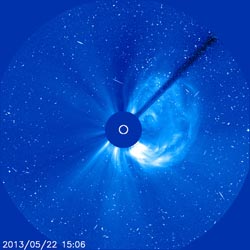NASA's SDO Observes Mid-level Solar Flare

This image, captured at 11:06 a.m. EDT on May 22, 2013, from the ESA/NASA Solar and Heliospheric Observatory shows theconjunction of two coronal mass ejections streaming away from the sun. This image is what's known as a coronagraph, in which the light of the sun is blocked in order to make its dimmer atmosphere, the corona, visible. Credit: ESA and NASA/SOHO <br>
While this CME was not Earth-directed, it has combined with an earlier CME, and the flank of the combined cloud may pass Earth. Particles from the CME cannot travel through the atmosphere to harm humans on Earth, but they can affect electronic systems in satellites and on the ground.
Experimental NASA research models, based on observations from NASA’s Solar Terrestrial Relations Observatory and ESA/NASA’s Solar and Heliospheric Observatory show that the first CME began at 5:12 a.m. EDT, leaving the sun at about 400 miles per second. The second CME began at 9:24 a.m. EDT, leaving the sun at speeds of around 745 miles per second.
Earth-directed CMEs can cause a space weather phenomenon called a geomagnetic storm, which occurs when they funnel energy into Earth's magnetic envelope, the magnetosphere, for an extended period of time. In the past, geomagnetic storms caused by CMEs of this strength have usually been mild.
The NASA models also show that the combined CMEs will pass by the STEREO-A spacecraft and its mission operators have been notified. If warranted, operators can put spacecraft into safe mode to protect the instruments from the solar material.
NASA and NOAA – as well as the US Air Force Weather Agency (AFWA) and others — keep a constant watch on the sun to monitor for space weather effects such as geomagnetic storms. With advance notification many satellites, spacecraft and technologies can be protected from the worst effects
NOAA's Space Weather Prediction Center (http://swpc.noaa.gov) is the U.S. government's official source for space weather forecasts, alerts, watches and warnings.
The sun emitted a mid-level solar flare on the morning of May 22, 2013. The flare peaked at 9:38 a.m. EDT and was classified as an M7. M-class flares are the weakest flares that can still cause some space weather effects near Earth. In the past, they have caused brief radio blackouts at the poles.
Solar flares are powerful bursts of radiation. Harmful radiation from a flare cannot pass through Earth's atmosphere to physically affect humans on the ground, however — when intense enough — they can disturb the atmosphere in the layer where GPS and communications signals travel. This disrupts the radio signals for as long as the flare is ongoing, anywhere from minutes to hours.
Increased numbers of flares are quite common at the moment, since the sun's normal 11-year activity cycle is ramping up toward solar maximum, which is expected in late 2013. Humans have tracked this solar cycle continuously since it was discovered in 1843, and it is normal for there to be many flares a day during the sun's peak activity.
NOAA's Space Weather Prediction Center (http://swpc.noaa.gov) is the U.S. government's official source for space weather forecasts, alerts, watches and warnings. Updates will be provided as they are available on the flare and whether there was an associated coronal mass ejection or CME, another solar phenomenon that can send solar particles into space and affect electronic systems in satellites and on Earth.
Karen C. Fox
NASA's Goddard Space Flight Center, Greenbelt, Md.
Media Contact
All latest news from the category: Earth Sciences
Earth Sciences (also referred to as Geosciences), which deals with basic issues surrounding our planet, plays a vital role in the area of energy and raw materials supply.
Earth Sciences comprises subjects such as geology, geography, geological informatics, paleontology, mineralogy, petrography, crystallography, geophysics, geodesy, glaciology, cartography, photogrammetry, meteorology and seismology, early-warning systems, earthquake research and polar research.
Newest articles

Superradiant atoms could push the boundaries of how precisely time can be measured
Superradiant atoms can help us measure time more precisely than ever. In a new study, researchers from the University of Copenhagen present a new method for measuring the time interval,…

Ion thermoelectric conversion devices for near room temperature
The electrode sheet of the thermoelectric device consists of ionic hydrogel, which is sandwiched between the electrodes to form, and the Prussian blue on the electrode undergoes a redox reaction…

Zap Energy achieves 37-million-degree temperatures in a compact device
New publication reports record electron temperatures for a small-scale, sheared-flow-stabilized Z-pinch fusion device. In the nine decades since humans first produced fusion reactions, only a few fusion technologies have demonstrated…





















